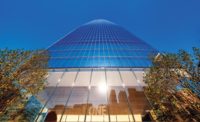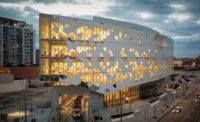Multifaceted structure supports audaciously sculptural BMW Welt
The 172,000-square-foot roof that seems to hover over Coop Himmelb(l)au’s BMW Welt in Munich does more than keep out the elements. Together with the Double Cone—a 43-foot-tall, hourglass-shaped event and exhibition space—the wildly sculptural roof serves as the chief expressive element for the building, which functions as part automobile distribution center, part conference center, and part marketing tool.
 Photo © Duccio Malagamba |
| From the second-level pedestrian bridge, visitors can glimpse the Premiere area where the purchased cars are transferred to their owners. Additional cars are on display on the plaza level. |
The undulating, stainless-steel-clad roof is like a tornado with the glass-and-metal-mesh-enclosed Double Cone as its vortex. To achieve this effect, the designers conceived the enclosure of the event space as a framework shell made of horizontal rings, curved ascending profiles, and diagonals. All are steel tubes, rectangular in section. “A typical structure would have horizontal elements, vertical elements, and diagonals to brace it,” says Klaus Bollinger, principal of Bollinger+Grohmann Engineers, the project’s structural consultant. “But we only have horizontals and diagonals. Then we twisted them so the structure would seem dynamic,” he says.
Designers sized the spacing between the structural elements so that the Double Cone’s glazing would not require a secondary structure. The nearly 900 triangular pieces all have different profiles. “This is not so difficult to organize by means of the computer,” remarks Bollinger.
The undulating roof is composed of two spatially distorted girder-grid layers, diagonal trusses, and vertical posts at selected points. This enormous steel space frame, with trusses as deep as 50 feet, makes possible the almost column-free hall within which individual programmatic elements are arranged like buildings within a building. These multilevel elements are the largely reinforced-concrete Tower and Forum, which house restaurants and an auditorium, respectively, and the primarily steel structure containing the lounge above the ground-floor vehicle delivery area, known as the Premiere. Though the lounge is supported through its vertical core and at several other points, it is almost enveloped in the roof cloud and appears to float. The roof is coupled with the structure of the Tower, Forum, and lounge, as well as that of the Double Cone, and is additionally supported with 11 columns.
Since the roof works as a complete structural entity, it could only bear loads after being almost entirely assembled. Contractors built the roof in two sections, first constructing the southern portion surrounding the Double Cone and the Tower. They assembled the two halves on temporary support towers, and then lowered them, via hydraulic jacks, to link with the permanent supports. They planned the sequence of assembly and load transfer carefully to avoid an uneven distribution of loads.
Not so surprisingly, the complex project involved intense collaboration and coordination among the various design disciplines and continuous updating of a shared three-dimensional model. Working in this way is by now old hat to Bollinger, whose firm was structural engineer on such sculptural projects as Peter Cook and Colin Fournier’s Kunsthaus in Graz [record, January 2004, page 92], and Zaha Hadid’s recently completed Nordpark cable railway stations in Innsbruck. “One 3D model for everyone is how we work,” says Bollinger. “That is how we realize such free-form buildings.”






